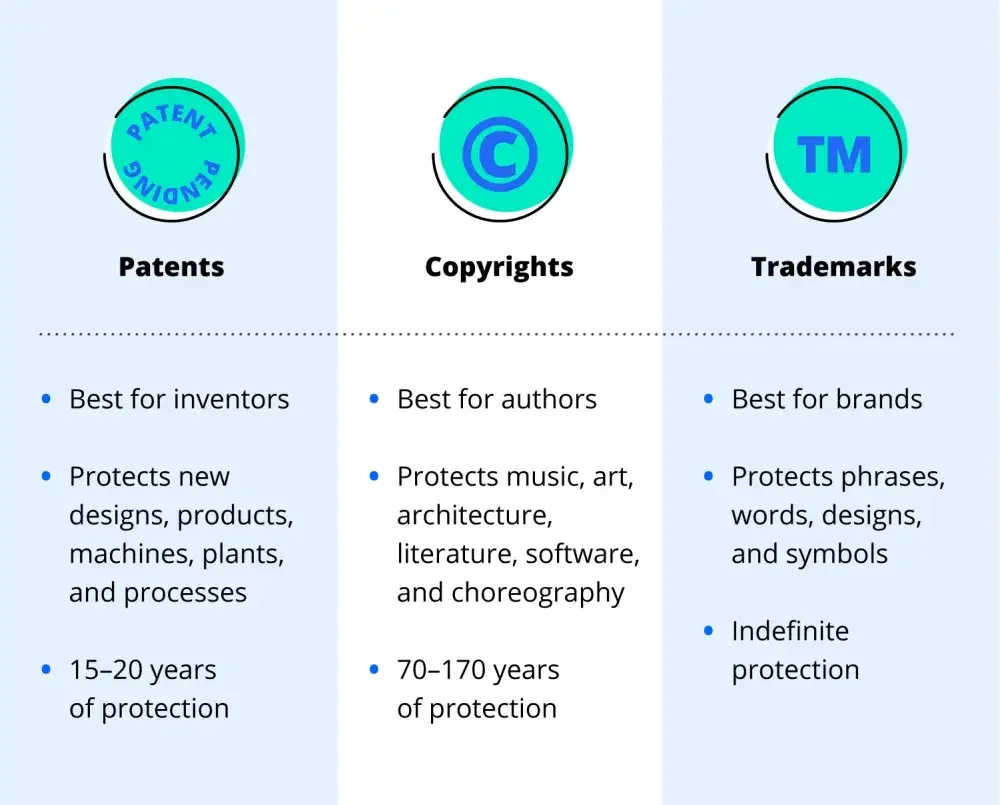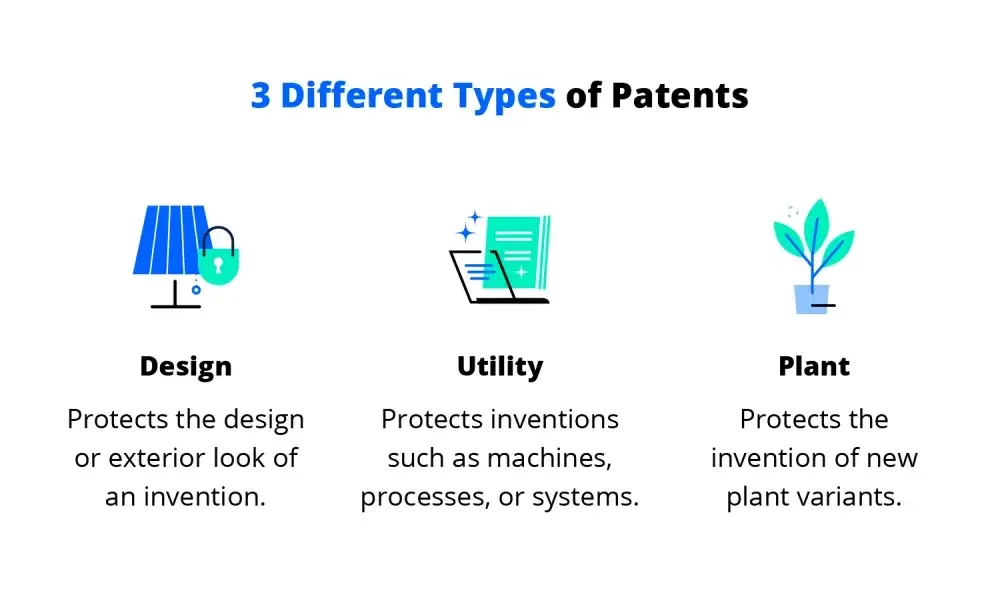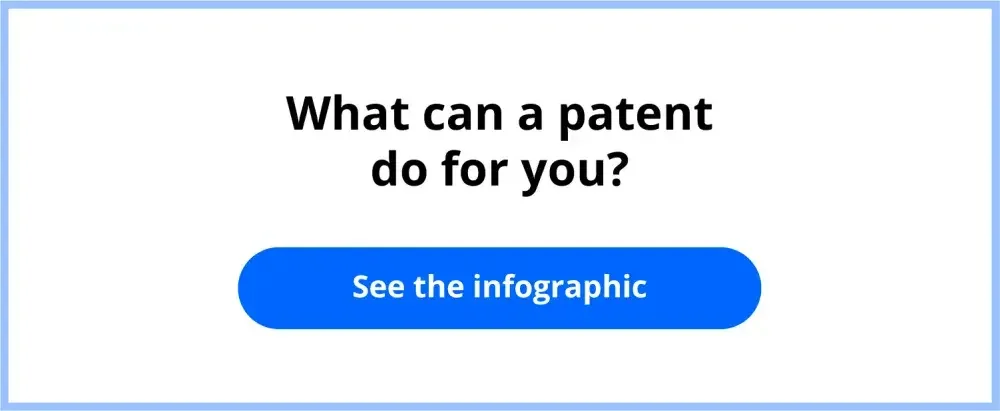If you're an inventor or visionary, you've probably dreamed of patenting a creation. From robotics and social distancing trackers to a customizable desk organizer, there were 646,244 applications for patents in 2020. But an application doesn't guarantee approval. According to the U.S. Patent and Trademark Office (USPTO), the federal agency that oversees and issues patents, only about 53% of applicants are awarded a patent.

Not every invention is patentable—or even worth patenting. But understanding patent basics and what the USPTO is looking for can help you get approved. Read on to learn about how a patent works, the different types of patents, the protections provided, and if they're right for your idea.
What is a patent?
A patent is an exclusive right that prevents anyone else from making, using, selling, distributing, importing, or selling your invention without permission for a set period of time. This timeline can extend up to 20 years, depending on the type of patent.
Provisional patent application
Under U.S. law, as part of the utility patent process, you can file a less formal provisional patent application that documents your claim to an invention while giving you time to perfect, experiment, determine commercial viability, etc.
This process gives you an extra year to plan your formal filing and gives you a priority filing date. Once your provisional patent application is granted, you can identify your invention as patent pending.
As the patent owner, you can sell or give your ownership to anyone you want. When the patent expires, your invention becomes available to the public, and anyone can sell, make, or use it from then on.
What protections do patents provide?

A patent gives you absolute ownership over your invention and prevents others from profiting off your thinking and hard work. A patent attorney can assist you through this process as well, as they specialize in patent law and practice. Here are other rights that the patent holder has under a patent:
- Right to claim damages: A patent holder has a right to damages for infringement if an infringer is using their patented invention without permission. The patent holder may also have a right to damages if the infringer's invention is substantially similar to the original invention.
- Right of sale: A patent holder has the right to sell, import, or manufacture their invention as they wish.
- Right to grant a license: A patent holder has the right to grant a license for the use of their invention to a third party. This allows the third party to legally use and benefit from the patent.
Patent examples
There are many inventions that have been created to make our lives easier. Here are some key inventions throughout history that have been patented:
- The internal combustion engine: Without this invention, vehicles wouldn't be possible. The first engine was patented in 1823 by Samuel Brown.
- The lightbulb: One of the most famous patents was awarded to Thomas Edison for the invention of the electric lightbulb in 1878. Edison achieved 1,093 patents in his lifetime.
- The television: The patent for the first television system was given to Philo Taylor Farnsworth in 1930.
- The computer: Steve Jobs and his colleagues at Apple patented his invention of the personal computer in 1983.
Some lesser-known patented ideas include:
- Chicken eye protectors: In 1908, Andrew Jackson Jr. patented eye protectors for chickens with the purpose of preventing them from pecking each others' eyes out.
- Steel kidneys: Nils Alwall patented the first steel kidneys in 1946 to help those suffering from kidney disease.
- The car coffee machine: This invention was patented in 1993 as a way to brew coffee right in your car—complete with a splash guard to prevent spillage while on the highway.
- Magnetic locker wallpaper: This was created in 2008 by a student who wanted to dress up her locker.
Patents vs. copyrights vs. trademarks

Knowing the difference between patents, copyrights, and trademarks can be confusing. Here's a breakdown of what each one protects and their differing characteristics:
Trademarks
Trademarks are protections for any phrase, word, design, symbol, or combination of these that identifies a service or good and distinguishes its source from others in the marketplace. Patents, on the other hand, aim to protect inventions.
Obtaining a trademark does not mean you own the word or phrase—it only provides protections if that word or phrase is attached to your particular service or good. However, trademarks don't have an expiration date like patents do—trademarks can last forever if properly maintained. Some examples of trademarks include McDonald's signature golden arches logo, the Coca-Cola font, and the Nike swoosh symbol.
Copyrights
Copyrights are a type of intellectual property that allows the owner the legal right to create copies, reproductions, perform, and display creative works for a set period of time. Some copyrights can be set in place for up to 120 years.
Examples of works that can be protected by copyright include music, art, architecture, literature, choreography, and software. In contrast, patents protect inventions.
What are the different types of patents?

Utility patents protect inventions for up to 20 years in the United States. But there are different types of patent categories with their own eligibility requirements that protect specific types of inventions. Here are the different types of patent applications and how they differ:
Design
Design patents only protect the ornamental exterior or look of a product that has practical use. The invention must have a useful and original design. An example of this type of patent is the original Coca-Cola bottle design.
- Patent duration: 15 years
Utility
Utility patents are an umbrella of inventions that most people think of when they hear "patent." A utility patent is a highly detailed technical document that details how a new machine, process, or system works and offers a powerful form of protection. This patent has protected a broad range of inventions like the broom, computers, business processes, and pharmaceuticals.
- Patent duration: 20 years
Plant
Plant patents aim to protect an inventor who has created a unique variety of plant. For example, new varieties of roses and apples have been protected by plant patents. This is the least frequently granted patent.
- Patent duration: 20 years
What is patentable?
Before filing for a patent, be sure to conduct research on your invention's patentability to see if it meets the requirements. Under U.S. patent law, anyone can be awarded a patent if they invent or discover something new and useful. In order to be eligible for a utility patent, your invention must fall under one of these categories:
- Processes: Like an assembly line process or online ordering system
- Machines: Any machine with parts, like a motorcycle
- Articles of manufacture: Inventions that are manufactured and achieve a result, such as a tool or a machine
- Composition of matter: Inventions that are chemical compositions, like a drug with a new chemical structure
Devising an improvement to an already known invention can also be patented.
Patent Idea Requirements
There are a few factors to keep in mind if you'd like to file for a patent. To be considered for a patent, your invention must also be:
- Novel: Your invention must be new and different in some way from previous inventions. It can't be made public in any way before the date on which the patent application is filed.
- Useful: It must provide a practical benefit and help accomplish something.
- Non-obvious: Someone skilled in the invention's field would not consider it obvious when compared to inventions that are already on the market.
Should you get a patent?
Patents are expensive and a lot of work. At the same time, they are highly valuable—a prized form of intellectual property. Below are two major factors you should consider before filing for a patent:
Will it help your business?
Patents are property, and you can exclude trespassers from your property. If you are going to file a patent, is it the kind of property your business needs?
For example, let's say your invention is a machine with a particular configuration of parts. If your competitors start producing and selling the same machine, then it would be fairly straightforward to determine if your competitor is infringing on your patent. Buy the machine, take it apart, and look at the components. If it's the same as your patented invention, then you have a trespasser—time to kick them off your property.
If, however, your patent is a method of manufacturing, proving infringement may be more complicated. If you need to gain access to your competitor's factory and watch them produce their goods in order to determine if your competitor is infringing on your patent, then your patent is much more difficult to enforce. Patent rights that are difficult to enforce tend to be less valuable.
Your patent has to add value to your business. Make sure you're acquiring valuable property that you can evict trespassers from.
Do you have the budget for it?
If you have a patentable invention that fits your business model and is novel, then the next step is filing a patent application.
The patent process is a commitment, often taking years to go from application to enforceable claims. And once a patent is awarded, the inventor must pay maintenance fees in order to keep it. For this reason, it helps to know how much you want to spend and when you'll have to spend it.
One way to manage how much and when you'll pay is to file a provisional patent application. A provisional patent lacks many of the formalities of a full patent application, which makes it substantially less expensive.
The provisional filing gives you 12 months to decide if you want to file a full patent application or if you want to walk away.
The provisional patent application gives you the benefit of an earlier filing date. If you're uncertain if you need a patent but may know better in 12 months, a provisional patent application may be the way to go.
Patent FAQs
The patent process has many steps and requirements but also provides many benefits to the inventor. Here are some commonly asked questions that relate to the patent process:
How long does a patent last?
The length of protection that a patent provides varies depending on the type of patent, but some can protect an invention for up to 20 years.
How much does a patent cost?
The cost of filing for a patent can range from thousands to tens of thousands of dollars, depending on the complexity of your invention and the type of patent you're applying for.
Are patents valid in all countries?
Patents are considered territorial rights, so the country in which you received your patent is the only country that it will be valid in.
How long does it take to get a patent?
According to the USPTO, patents take about 22 months to become approved. However, this may be expedited if you're eligible for a prioritized review, also known as Track One. This patent review process is shorter and takes about six to 12 months.
Tip: Follow up with the USPTO when possible to check on your patent approval status—this can help identify any delays or snags in the process.
What do I do if my patent gets rejected?
If your patent is rejected, the process doesn't have to end there. You can file for an appeal through the Patent Trial and Appeal Board. However, you may be subject to additional legal fees and pending approval time if you choose this option.
How do I find out if a patent already exists?
To conduct a patent search, you first have to know what makes your invention novel. That means: What is it that makes your product, service, or system new and different? To find out whether or not an invention has already been patented, you can search the USPTO database or use a patent search service.
Before filing for a patent, it's in your best interest to research how the marketplace might react to your invention before you file. If you uncover a real need and desire for your invention, you're on the right track. On the other hand, if the consensus is more indifferent, you might be better off not going through all the expense and hassle of the patent process.
You'll also want to take into account the cost of manufacturing your invention. If it's more than the market can bear, it's back to the drawing board. But if it's cost-effective to produce, securing a patent could be invaluable.


